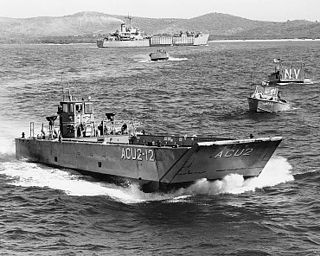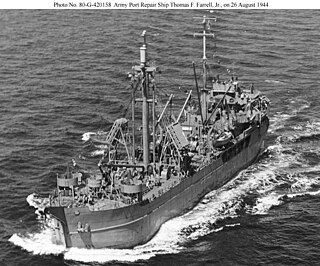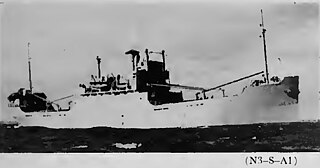
Military Sealift Command (MSC) is an organization that controls the replenishment and military transport ships of the United States Navy. Military Sealift Command has the responsibility for providing sealift and ocean transportation for all US military services as well as for other government agencies. It first came into existence on 9 July 1949 when the Military Sea Transportation Service (MSTS) became solely responsible for the Department of Defense's ocean transport needs. The MSTS was renamed the Military Sealift Command in 1970.

The LCM-8 is a river boat and mechanized landing craft used by the United States Navy and Army during the Vietnam War and subsequent operations. They are currently used by governments and private organizations throughout the world. The acronym stands for "Landing Craft Mechanized, Mark 8".

USS Oglala (ID-1255/CM-4/ARG-1) was a minelayer in the United States Navy. Commissioned as Massachusetts, she was renamed Shawmut a month later, and in 1928, was renamed after the Oglala, a sub-tribe of the Lakota, residing in the Black Hills of South Dakota.

Europa (AK-81) was never commissioned and thus never bore the USS designation.

Nashira (AK-85) was planned as a civilian cargo ship for the United States Maritime Commission, transferred to the Navy for construction then transferred to the U.S. Army and renamed two days after launching. The ship was never commissioned, thus never bore the USS designation, and had no significant naval service. The ship was converted to the U.S. Army Engineer Port Repair ship Richard R. Arnold and served in the Pacific during 1945.

USS Hydra (AK-82), ex MV Eben H. Linnell, was an Enceladus-class cargo ship commissioned by the U.S. Navy for cargo service in World War II. Hydra was in naval service from 1 January through 19 November 1943 before she was transferred to the U.S. Army for conversion to the Engineer Port Repair ship Madison Jordan Manchester.

Media (AK-83) was a World War II US navy ship that was never commissioned and thus never bore the USS designation.

Mira (AK-84) was never commissioned and thus never bore the USS designation. The ship was transferred to become the U.S. Army Corps of Engineers Port Repair ship Robert M. Emery the day after acquisition by Navy.

Norma (AK-86) was never commissioned and thus never bore the USS designation. Norma is the name of constellation.

Sagitta (AK-87) was never commissioned and thus never bore the USS designation.

Tucana (AK-88) was never commissioned and thus never bore the USS designation. She was transferred upon launching on 13 September 1944 to the U.S. Army as the U.S. Army Engineer Port Repair ship Arthur C. Ely.

Vela (AK-89) was never commissioned and thus never bore the USS designation. The ship was transferred to the Army to become the Engineer Port Repair Ship Joe C. Specker shortly after launching. She was one of two such repair ships transferred to Navy in 1952 and served as the civilian crewed, unarmed USNS Vela (T-AK-89).

Junior N. Van Noy was a Great Lakes steamer converted as one of ten U.S. U.S. Army Port Repair ships to be operated by the U.S. Army Corps of Engineers in rehabilitating war damaged ports. The other nine ships were Maritime Commission type N3–M–A1 cargo ship hulls built under U.S. Navy supervision and transferred upon completion or after very brief Navy service to the U.S. Army for conversion to port repair ships.

Type N3-S ships were a Maritime Commission small coastal cargo ship design to meet urgent World War II shipping needs, with the first of the 109 N3, both steam and diesel, type hulls delivered in December 1942.
SS Robin Doncaster was a 7,101 GRT cargo liner that was built in 1940 as a Type C2-S cargo ship by Bethlehem Steel Co, Sparrows Point, Maryland, United States for the United States Maritime Commission (USMC). On completion in April 1941, she was transferred to the Ministry of War Transport (MoWT) and renamed Empire Curlew. In 1942, she was transferred to the USMC, regaining her former name Robin Doncaster. She was rebuilt as a troop transport, and entered service with the War Shipping Administration in January 1944. She was returned to the USMC in April 1946 and was sold to Seas Shipping Co Inc in 1948. In 1957, she was sold to Isbrandtsen Lines and was renamed Flying Gull. Sold to American Export Lines in 1962, she served until she was scrapped in 1968.
SS Haiti was a passenger and freight ship built for the Colombian Mail Steamship Company built at Newport News Shipbuilding, Newport News, Virginia and delivered 15 December 1932. The ship was renamed briefly Puerto Rico in 1938 and Monterey in 1939 to operate for the New York and Cuba Mail Steamship Company until requisitioned with transfer of title to the War Shipping Administration (WSA) on 25 September 1942. The ship was then allocated to the U.S. Army for operation under a bareboat agreement as USAT Monterey. In 1943 the ship was assigned to the command at Trinidad to supply bases in Brazil and Ascension Island. After layup in the reserve fleet the ship was sold to Turkey.
Kuroshio Maru was a tanker that was built in 1938 for Japanese owners. She was chartered by the Imperial Japanese Navy and Imperial Japanese Army during World War II: the ship was sunk in January 1945 at Takao, Formosa by American aircraft. Salvaged in 1946, she was allocated as a war prize to China and renamed Yung Hao, but was forced to remain at Hong Kong by the British. She was requisitioned by the Admiralty during the Korean War and allocated to the Royal Fleet Auxiliary. She was to have been named RFA Surf Pilot but due to her poor condition she did not serve in the Royal Fleet Auxiliary. She served as Surf Pilot, a tender to HMS Terror until 1958 and was subsequently scuttled off Pulau Aur, Malaya in 1960.

ABSD-3 is an advanced base sectional dock, constructed of nine advance base dock (ABD) sections for the US Navy as an auxiliary floating drydock for World War II. ABSD-3 was delivered to the US Navy in April 1944, and was commissioned on 27 October 1944. Advance Base Sectional Dock-3 was constructed in sections during 1942 and 1943.










